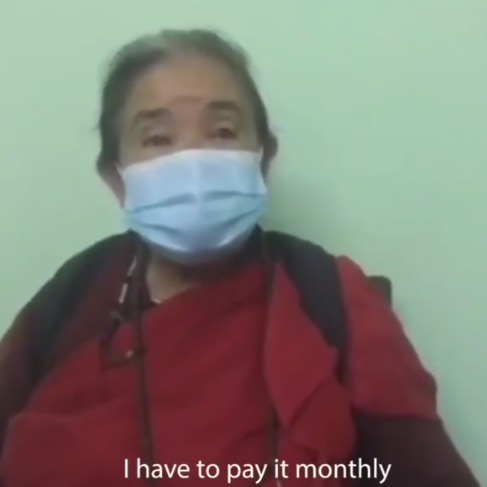- Approximately 10,000 Tibetan refugees in Nepal
- Tibetans in Nepal have no legal status as refugees
- They can’t work officially, open a bank account or start a business
- Most Tibetans make a meagre living illegally by weaving carpets, spinning wool or selling small handicrafts and jewellery
Our work in Nepal focuses on education, skills training and the elderly. We have also been working to rebuild Bakhang village after the 2015 earthquakes in a more environmentally sustainable way.
Bakhang

Bakhang village and its surroundings are home to approximately 2,000 ethnic Tibetans. Located in Sindhupalchok, a mountainous area of Nepal on the border with Tibet, the village is so remote that it isn’t marked on Google Maps. During the rainy season it is a six hour walk from the nearest road, as the road up to the village gets washed away.
Tibet Relief Fund has worked with the village since 2008, supporting the local school. The village was badly affected by the devastating earthquakes of 2015 and in the following years we worked to rebuild the primary school and 14 houses for the most vulnerable families. We are in the final stages of building a new health post.
Bakhang school: teachers & nutrition
Tibet Relief Fund has been supporting the salaries of two Tibetan teachers at Bakhang’s primary school since 2008, to ensure the children can get a good education and learn their own language and culture as well as the standard curriculum in Nepal. We also provide extra nutrition for the children in the form of eggs, milk and fruit to supplement their basic diets.
Bakhang: A new health post
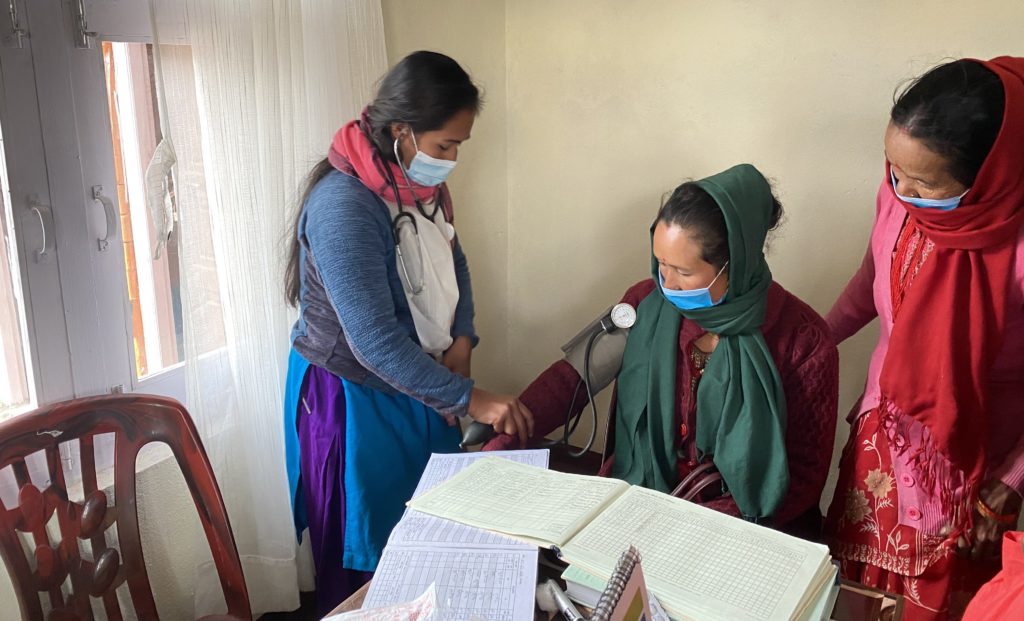
In-depth consultations with the local community in 2020 revealed an urgent need for a permanent health post to serve the residents of Bakhang and the surrounding area.
Currently the nearest health post is 15km away, which takes about three hours on foot or two hours off-road by car to reach. This means most people only seek medical attention in very serious cases, or when it is too late. Elderly residents would often have to be carried on people’s backs to get medical care. Residents also tended to self-medicate with paracetamol rather than seek help at the early stages of an illness.
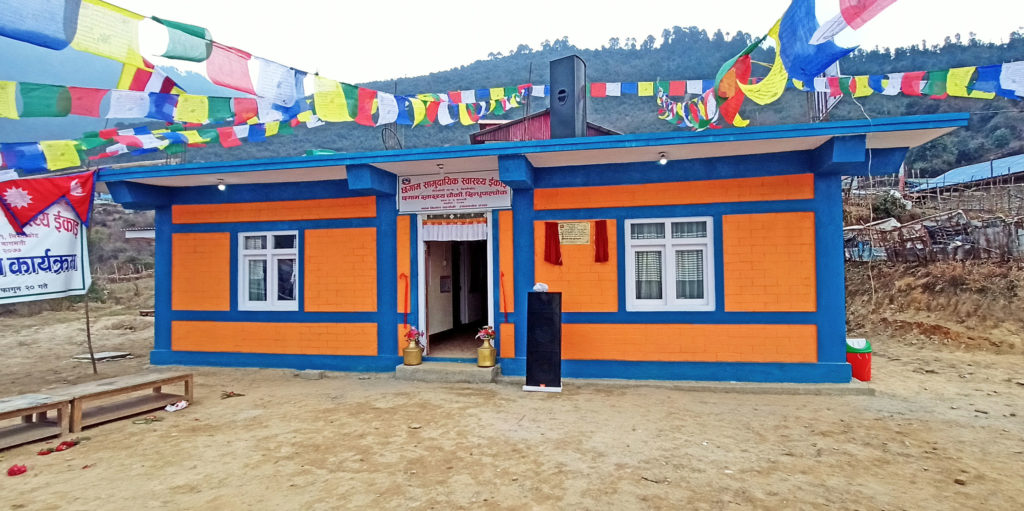
We funded a new health post for Bakhang in 2020, built by the residents themselves with their new construction skills under the supervision of Build Up Nepal. Since opening in March 2021 it has already treated 450 people and the residents are delighted with their new health post. The village now has a safe space for visiting doctors to conduct examinations and procedures and store medicines.
We are now building staff quarters for the health post with a grant from Guernsey Overseas Aid. Once these are in place, this will unlock a commitment from the local government to staff the health post with two permanent healthcare workers, including a nurse-midwife, ensuring the residents of Bakhang have continuous access to medical care. This is planned to be finished by spring 2022.
Houses for vulnerable families
The Nepal earthquakes in April and May 2015 devastated the village. In 2019 we worked with Build Up Nepal to rebuild the homes of 14 vulnerable families, who were living in unsafe temporary shelters. The residents worked hard to rebuild their own homes, and are now enjoying their new earthquake-resistant houses.
“Our temporary shelter was leaking from all sides. We are very grateful and happy to have a new, safe home.”
Lakpa
We would like to give a special mention to Ian Logan, who gave a generous donation of £15,000 to rebuild six of the houses.
In 2022 we are raising £24,000 to rebuild the houses of the next seven families most in need, as agreed by the Bakhang community.
Bakhang school rebuild – Completed 2017
Bakhang’s primary school was destroyed by the 2015 earthquakes, leaving the villagers feeling desolate. Children had to go to school in makeshift tents, which were cold and offered little protection. Attendance halved as parents were reluctant to send their children to school after the trauma of the earthquakes.
In 2017 we worked in partnership with Build Up Nepal to rebuild the school. We provided the village with a machine to make earth bricks from local materials, which reduces the cost and cuts carbon emissions by up to 60% compared with traditional fired bricks. The bricks are interlocking so they are very simple to use – just like giant Lego bricks! The buildings are strengthened using metal bars and pillars, making the finished product highly earthquake-resistant.
Residents learned earth brick production and building skills as part of the project, which they can use in future to earn money and develop their village. Women and girls in particular benefited from learning these new skills and took a lead role in the rebuilding.
The new primary school opened in January 2018 and the whole village turned out for the opening ceremony! The children are now all back at school and enjoying classes in the new building.
This really was a great achievement for the community and the first of several rebuilding projects in Bakhang.
Lodrik Welfare Fund
Lodrik Welfare Fund was set up in the 1970s to look after Tibetan ex-freedom fighters and their families. The former guerillas are now elderly and unable to work; many never married so don’t have families to help them in their old age. Most live in Jampaling and Paljorling settlements near Pokhara, but some live in Kathmandu and India.
Tibet Relief Fund has worked with Lodrik for many years to provide essential care for elderly Tibetans, emergency medical treatment and skills training for young Tibetans.
Care for elderly Tibetans
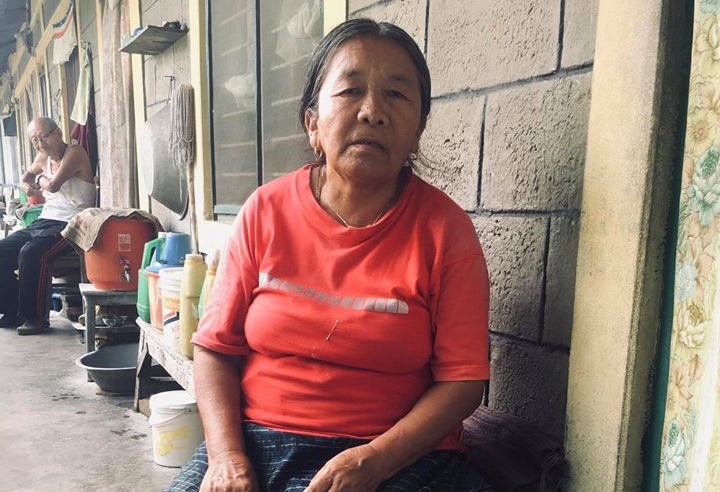
The elderly refugees under Lodrik’s care have led hard lives. Many sacrificed years fighting for Tibet’s freedom, others worked extremely physically demanding jobs like road-building to make enough money to survive in exile, and they all deserve to live in dignity and comfort in their old age. We support them through monthly stipends which means they can afford basic necessities and have some financial independence with money of their own.
Passang, 76, receives a monthly stipend. She is one of many elderly Tibetan refugees living in the Lodrik settlements in Pokhara, Nepal. Passang’s husband has passed away, she has no children and she has epilepsy so cannot work. Thanks to your support, she is able to live in dignity and comfort
“I know life isn’t always sunshine and roses. Especially during this stage the stipend provided by the Tibet Relief Fund has made an actual difference in not just my life but many elders of our settlement. So, we truly appreciated the support and help given by your organisation through Lodrik Welfare Office. I can’t express how blessed we feel compared to many unfortunate one around the world. So, truly thank you.”
Passang
Emergency medical fund
The emergency medical fund ensures a vital safety net for many members of the Lodrik community, who often cannot afford the treatment they need. In 2020, 41 people received a medical grant to help them with a range of health problems.
One of these was Mrs. Pema, a widow from Paljoring settlement. Thanks to the medical fund she could have eye surgery and can now see much better and take care of her aging mother.
Skills training for young Tibetans
For young Tibetans in Nepal developing professional skills is vital in order to earn a living. Standard routes through education don’t always guarantee this – Tibetans in Nepal have uncertain status and can’t always access the same opportunities as Nepali citizens.
The skills training grant supports unemployed young people and women in the settlement to gain practical skills through vocational training. Many had little or no prior training and the programme is helping many people to find jobs in their chosen field. In 2020 six young people completed training in mobile phone repairs, bartending and hairdressing.
Tenzin Tsepal, 16, completed a 3-month mobile repair training course. He now runs a small repair shop fixing common mobile problems such as battery, display and water damage. Tenzin is now feeling motivated to do advanced mobile and computer training and eventually pursue a career in computer sciences
As of November 2021, 16 young people are doing skills training with the help of our grant. We are also starting up a new revolving loan scheme to help young Tibetans start their own businesses and expect this to be active by early 2022.
Nangchen elderly refugees
After 1959, large numbers of Tibetans from the Nangchen region of east Tibet fled to India and Nepal. In their early years of exile, some senior citizens of Nangchen set up a social organisation, or ‘Kyiduk’ to preserve language, culture and tradition as well as to care for the poor, sick and needy. In 1968 it became the Nangchen Nyernga Social Service Society and now runs an old people’s care home and looks after elders within the community.
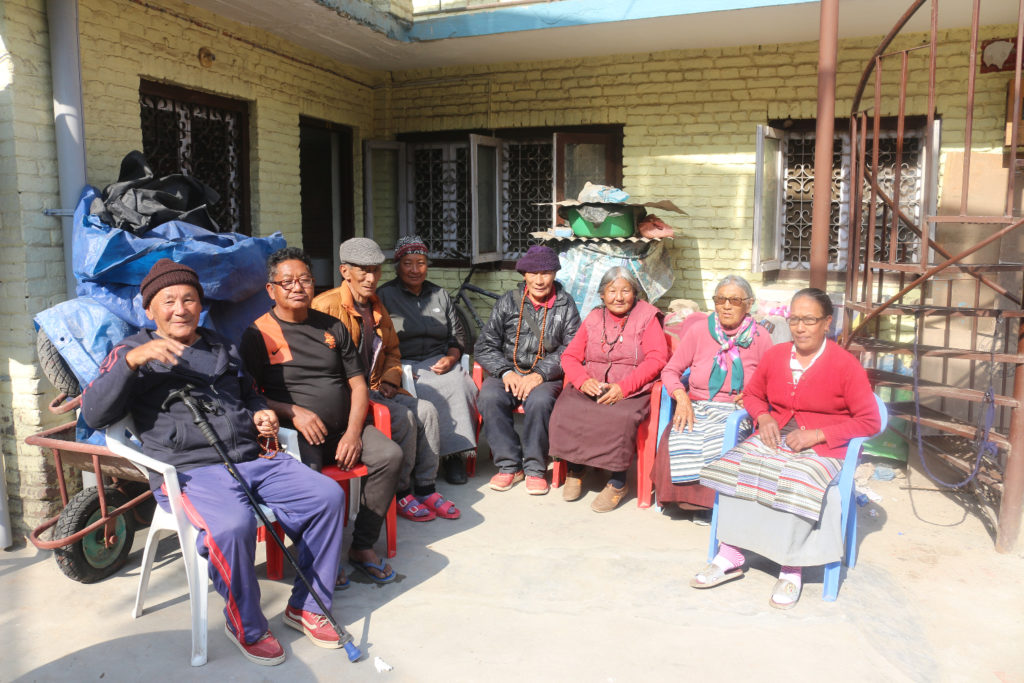
Tibet Relief Fund has been working with Nangchen since 2010 to support the elders living at the centre near Swayambhunath in Kathmandu.
Our current support funds the salary for a cook so the elders always have nutritious home-cooked meals, medical emergencies, stipends for the elders and a supply of regular drinking water tankers.
Completed
Emergency food & rent relief – Completed 2021
Due to the Covid-19 pandemic, Nepal went into a national lockdown in late March 2020. This continued for a long time at varying levels, and had a devastating impact on the tourism and hospitality sectors.
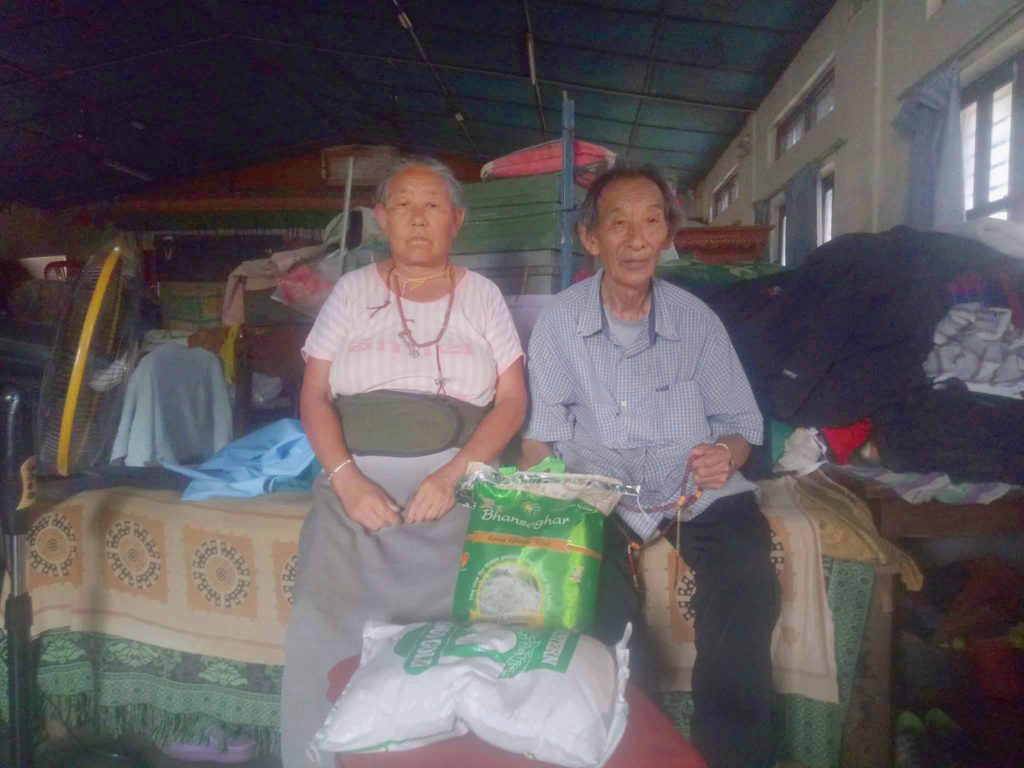
Many Tibetans in Kathmandu and Pokhara are daily wage earners or depend on tourism so have had little or no income since then. Added to this, many in Kathmandu lived in rented accommodation and were at risk of eviction. Through our Project Liaison Officer, Penpa Tsering, we identified around 40 households (100 vulnerable individuals) needing emergency assistance with food and rent in Kathmandu. Similarly, Lodrik Welfare Fund had approached us for emergency food relief for nearly 700 Tibetans living in the three Lodrik settlements in Pokhara.
Your donations to our appeals helped us deliver enough dal, rice, atta, cooking oil and tea for a month to the most vulnerable Tibetan refugees in the Kathmandu and Pokhara areas, giving them food security and making them feel cared for and supported.
You also ensured that 76 families and individuals in Kathmandu received two months’ rent relief, giving a welcome respite to people who are struggling with lack of income.
Mrs Duntso (pictured), 66, said “I just would like to say thanks a million times and I will be forever grateful for your support.”
Nangchen water filter – Completed 2017
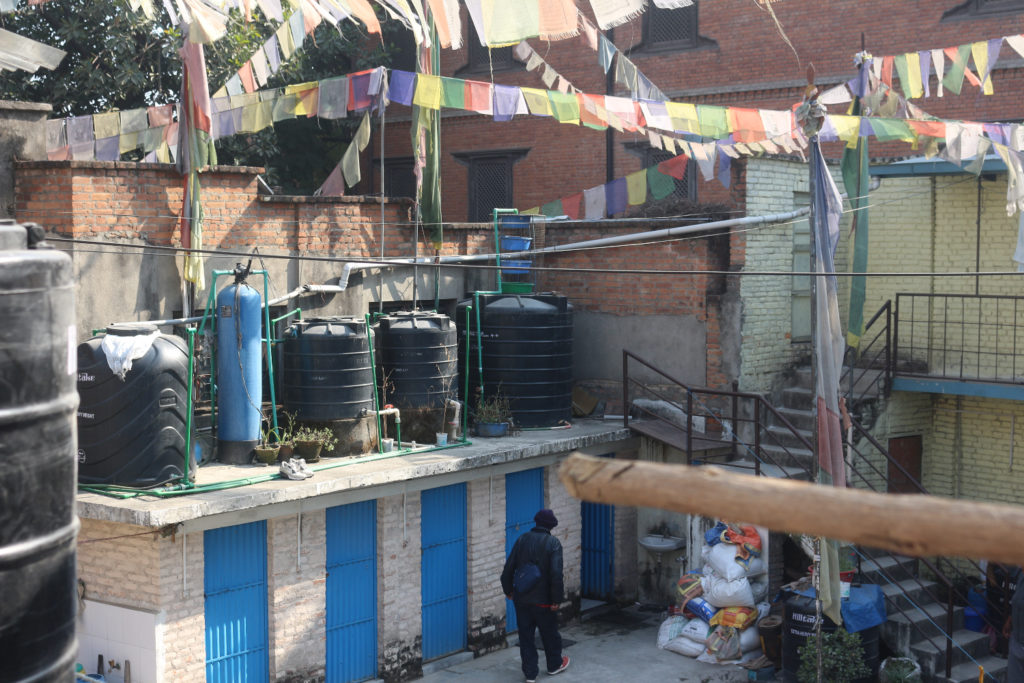
After 1959, large numbers of Tibetans from the Nangchen region of east Tibet fled to India and Nepal. In their early years of exile, some senior citizens of Nangchen set up a social organisation, or ‘Kyiduk’ to preserve language, culture and tradition as well as to care for the poor, sick and needy. In 1968 it became the Nangchen Nyernga Social Service Society and now runs an old people’s care home and looks after elders within the community.
Tibet Relief Fund has been working with Nangchen since 2010* to support the elders living at the care home near Swayambhunath in Kathmandu.
For years, the home has been drawing their drinking water from underground. The residents at the home have had to drink only brown, dirty water and they often used to get ill.
Tibet Relief Fund supporter Susan Cran very generously donated to cover the cost of installing a filter to provide clean, safe drinking water. The filter was installed in 2017.
This served the home well for several years, ensuring the elders had clean drinking water and fewer illnesses, but there have recently been issues with water supply in the area. Tibet Relief Fund is funding regular tankers of drinking water for the home until these issues are resolved.

